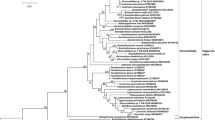Abstract
The life cycle was investigated of a trematode of the genusPlagiorchis, named provisionallyPlagiorchis spec. 1. Cercariae were obtained from the fresh-water snailLymnaea stagnalis L. from two localities remote from each other: the Roggenburg fish-ponds near Ulm, Federal Republic of Germany, and the “Obedska bara” nature reserve near Belgrade, Yugoslavia. Material from the two trematode populations was used separately for infection experiments and compared, to show the constancy of the morphological features of the developmental stages. Experimental second intermediate hosts were larvae of Ephemeroptera (Cloëon), Trichoptera, Zygoptera, Nematocera (Chaoborus, Culex-type, Chironomidae), Dytiscidae, and to a lesser degreeAsellus aquaticus. Chickens were fed with infested larvae and adult trematodes were recovered from the intestine. The first trematode eggs appeared in the faeces after 6–8 days. They matured within 30–50 days at room temperature. Laboratory-rearedLymnaea stagnalis from two age groups (3.5 months and 2 years) were fed mature eggs. Both age groups became infected by eggs of the Roggenburg population. Cercariae emerged after 44–54 days (room temperature) and were identical with those from the natural habitat. Further fresh-water snails were tested as possible first intermediate hosts by feeding them mature eggs. In oneGalba palustris Müll. the trematode investigated developed up to the cercarial stage, whereas experiments withRadix auricularia L.,R. peregra Müll. andPlanorbarius corneus L. were negative. The cercaria is a Xiphidiocercaria armata with seven penetration glands on one side and eight on the other. Its chaetotaxy is elaborated. The metacercaria is characterized by hardly any growth in the encysted stage and an active process of excystation. The morphology and biology of all developmental stages and the chaetotaxy of the cercariae were identical in both populations. The adults resemble several species in thePlagiorchis elegans group compiled by Krasnolobova. According to the life cycle, the investigated species mostly corresponds withPlagiorchis laricola as described by Ždárská andP. elegans as described by Styczyńska-Jurewicz and Samnaliev et al. There are differences and contradictory data in the literature on these species, which do not allow an exact determination until further knowledge about related forms is available.
Similar content being viewed by others
References
Bock D (1982) The life cycle ofOpisthioglyphe locellus Kossack 1910 (Trematoda, Plagiorchiidae), a parasite of shrews (Soricidae). Z Parasitenkd 67:155–163
Bock D (1983) The chaetotaxy of the cercaria ofOpisthioglyphe locellus Kossack 1910 (Trematoda, Plagiorchiidae). Z Parasitenkd 69:35–39
Buttner A, Vacher C (1960) Recherches sur le développement et l'identification dePlagiorchis (Multiglandularis) cirratus (Rudolphi 1802). I. Etude du cycle évolutif. Ann Parasitol Hum Comp 35:268–281
Dollfus RPh (1925) Distomiens parasites des Muridae du genreMus. Ann Parasitol Hum Comp 3:185–205
Filimonova LV (1973) Žiznennyj ciklPlagiorchis obtusus (Trematoda, Plagiorchidae). Zool Ž. 52:766–769
Funk O (1982) Der Entwicklungszyklus des TrematodenPlagiorchis (Multiglandularis) laricola (Skrjabin, 1924) einem häufigen Parasiten von Lachmöwen des Federsees. Diplomarbeit Universität Hohenheim
Genov T, Samnaliev P On the biology, morphology and taxonomy ofPlagiorchis elegans (Rud. 1802). Helminthology (in press)
Grabda-Kazubska B, Moczoń T (1981) Nervous system and chaetotaxy in the cercaria ofHaplometra cylindracea (Zeder, 1800) (Digenea, Plagiorchiidae). Z Parasitenkd 65:53–61
Johnston TH, Angel M (1951) The life history ofPlagiorchis jaenschi, a new trematode from the Australian water-rat. Trans Soc South Aust 74:49–58
Krasnolobova TA (1971a) Biologičeskie osobennosti trematod rodaPlagiorchis (Lühe, 1899) Plagiorchiidae. Eksperimental'noe izučenie žiznennogo cikla trematodyPlagiorchis laricola (Skrjabin, 1924). Čast' I. Tr Gel'mintol Lab 21:43–57
Krasnolobova TA; (1971b) Biologičeskie osobennosti trematod rodaPlagiorchis. Razvitie trematodyP. laricola v okončatel'nych chozjaevach (čast' II). Tr Gel'mintol Lab 22:92–118
Krasnolobova TA (1977 Principy sistematiki trematod rodaPlagiorchis Lühe, 1899. Tr Gel'mintol Lab 27:65–110
Krasnolobova TA (1979) O razvitiiPlagiorchis elegans Lühe, 1899 v uslovijach del'ty Volgi. Tr Gel'mintol Lab 29:75–80
McMullen DB (1937) The life history of three trematodes, parasitic in birds and mammals, belonging to the genusPlagiorchis. J Parasitol 23:235–243
Najarian HH (1952) A new xiphidiocercaria,C. goodmani, fromLymnaea palustris. J Parasitol 38:157–160
Najarian HH (1961) The life cycle ofPlagiorchis goodmani n. comb. (Trematoda: Plagiorchiidae). J Parasitol 47:625–634
Odening K (1959) ÜberPlagiorchis, Omphalometra undAllocreadium. Z Parasitenkd 19:14–34
Odening K (1961) Zur morphologischen Variationsbreite vonPlagiorchis undOpisthioglyphe (Trematoda, Digenea). Mber Dt Akad Wiss B 3:188–202
Reichenow E, Vogel H, Weyer F (1969) Leitfaden zur Untersuchung der tierischen Parasiten des Menschen und der Haustiere. Johann Ambrosius Barth, Leipzig
Reimer L (1966/67) Zur Variabilität der TrematodenartPlagiorchis laricola (Skrjabin, 1924) und ihrer Entwicklungsstadien. Wiss Z Pädag Inst Güstrow 5:9–11
Richard J (1971) La chétotaxie des cercaires. Valeur systématique et phylétique. Mém Mus Nat Hist Nat [A] 67:1–179
Sâmnaliev P, Genov T (1980) Proučvanija vârchu cikâla na razvitie naPlagiorchis eutamiatis Schulz, 1932. Chelmintologija 9:57–64
Sâmnaliev P, Dimitrov V, Genov T (1982) Chaetotaxy ofPlagiorchis elegans (Rud., 1802) cercariae. Helminthologia 19:107–114
Styczyńska-Jurewicz E (1962) The life cycle ofPlagiorchis elegans (Rud., 1802) and the revision of the genusPlagiorchis Lühe, 1889. Acta Parasitol Pol 10:419–445
Théron A (1976) Le cycle biologique dePlagiorchis neomidis Brendow, 1970, digène parasite deNeomys fodiens dans les Pyrénées. Chronobiology de l'emission cercarienne. Ann Parasitol Hum Comp 51:329–340
Vaucher C (1972) Chétotaxie de la cercaire deOpisthioglyphe megastomus Baer, 1943 (Trematoda, Plagiorchidae). Rev Suisse Zool 79:1164–1169
Yamaguti S (1943) Cercaria ofPlagiorchis muris (Tanabe, 1922). Annot Zool Jpn 22:1–3
Yamashita J (1952) Studies on the cercaria of the rat trematode,Plagiorchis muris (Tanabe). J Fac Agric Hokkaido Univ 48:305–358
Ždárská Z (1966) Der Entwicklungszyklus des TrematodenPlagiorchis laricola (Skrjabin 1924). Věstn Čsl Spol Zool 29:179–184
Author information
Authors and Affiliations
Rights and permissions
About this article
Cite this article
Bock, D. The life cycle ofPlagiorchis spec. 1, a species of thePlagiorchis elegans group (Trematoda, Plagiorchiidae). Z. Parasitenkd. 70, 359–373 (1984). https://doi.org/10.1007/BF00927822
Accepted:
Issue Date:
DOI: https://doi.org/10.1007/BF00927822




